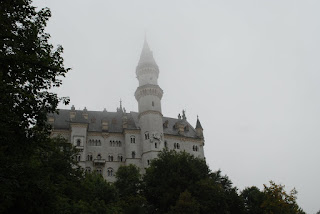 Our first sightseeing excursion of the tour was a cruise on the Rhine River. There were castles, churches and towns on either side. The castles and castle ruins are the highlights, appearing one after another with little property surrounding them. (Eleventh-century Sooneck Castle is above, and Reichenstein Castle from 1192 is below.) These mostly anonymous medieval landowners were always jousting with their neighbors for more land.
Our first sightseeing excursion of the tour was a cruise on the Rhine River. There were castles, churches and towns on either side. The castles and castle ruins are the highlights, appearing one after another with little property surrounding them. (Eleventh-century Sooneck Castle is above, and Reichenstein Castle from 1192 is below.) These mostly anonymous medieval landowners were always jousting with their neighbors for more land.SANSSOUCI
I've had this unread book on my shelf for 22 years that I bought in the 1980s after hearing a review on the radio. It's a biography of the non-anonymous Frederick the Great, King of Prussia. We music majors knew about Frederick because he was an excellent flutist and notable patron of the arts. We visited his palace on the tour, Sanssouci in Potsdam. Sanssouci means "without worries" and this palace became a headquarters for intellectuals and Frederick's sophisticated friends. Voltaire lived here for three years. Frederick's tomb is on the grounds, and visitors leave flowers and potatoes on it. Why potatoes? Because Frederick brought the plant to Germany to feed the hungry poor. He forgot to tell them right away that they were supposed to eat the bottom part of the plant. They were eating the leaves and not liking it very much.

CECILIENHOF
The other palace in Potsdam is Cecilienhof, where the Potsdam Conference starring Roosevelt, Churchill, and Stalin, and later Truman, Attlee, and Stalin, took place. It was in this palace that they signed the Potsdam Agreement after World War II.

LINDERHOF

Another superstar king was Ludwig II (sometimes referred to as Mad King Ludwig). He built
three famous iconic German castles, and we visited two on this tour. First, Linderhof with its man-made grotto and countless priceless porcelain vases. This castle, decorated in exaggerated Rococo style if tht's possible, features a waterfall fountain outside Ludwig's bedroom window. (see right.)
Linderhof's man-made Venus Grotto, a ten-minute walk up a steep hill, was a retreat for the king where he had his buddy Richard Wagner's opera, Tannhauser, performed while he floated around the man-made grotto lake in a boast shaped like a scallop shell. (Think Botticelli's "The Birth of Venus".)
NEUSCHWANSTEIN
Ludwig's other famous castle, Neuschwanstein, also has a grotto inspired by the work of Richard Wagner, but it also features a bigger tribute. The singer's Hall, a fancy Rococo auditorium, is decorated with murals depicting scenes from Wagner's operas. Ludwig loved music and he loved reading: both of these castles feature upholstered reading nooks. This is the famous fairy tale castle that inspired Cinderella's place at Disneyworld. We missed out on the "money shot" photo of the castle because of clouds, but there were still plenty of photo opps on the property:



No comments:
Post a Comment